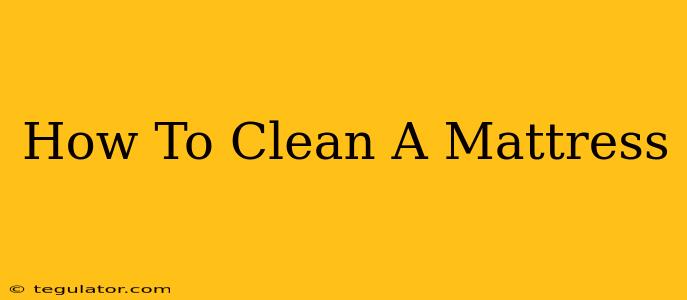A clean mattress is crucial for a healthy and restful sleep. Over time, mattresses accumulate sweat, dead skin cells, dust mites, and other allergens, impacting your sleep quality and potentially triggering allergies or asthma. This comprehensive guide will walk you through various methods for effectively cleaning your mattress, ensuring a hygienic and comfortable sleeping environment.
Understanding Mattress Types and Cleaning Needs
Before diving into cleaning methods, it's essential to understand your mattress type. Different materials require different cleaning approaches. Common mattress types include:
- Innerspring: These mattresses have coils and padding. They generally require less intense cleaning than foam mattresses.
- Memory Foam: These mattresses conform to your body shape and retain heat. They're more susceptible to stains and require careful cleaning to avoid damage.
- Latex: Latex mattresses are naturally hypoallergenic and durable. However, they need specific cleaning methods to maintain their integrity.
- Hybrid: Hybrid mattresses combine different materials, such as innersprings and foam. Their cleaning needs will depend on the dominant material.
Knowing your mattress type helps determine the appropriate cleaning techniques and solutions.
Essential Tools for Mattress Cleaning
Having the right tools on hand makes the cleaning process much easier and more effective. Gather these essential items:
- Vacuum cleaner with upholstery attachment: Crucial for removing dust mites, dead skin cells, and loose debris.
- Baking soda: A natural deodorizer and stain remover.
- White vinegar: Effective in neutralizing odors and killing bacteria.
- Spot cleaner (optional): For tackling specific stains. Choose a solution safe for your mattress material.
- Clean cloths or microfiber towels: For wiping and drying.
- Protective mattress cover: A waterproof cover is highly recommended to protect your mattress from future spills and stains.
Step-by-Step Mattress Cleaning Guide
Follow these steps for a thorough mattress cleaning:
1. Preparation is Key:
- Strip the bed: Remove all bedding, including sheets, blankets, comforter, and pillows. Wash everything in hot water to eliminate any accumulated allergens.
- Air it out: Open windows and let your mattress air out for several hours. This helps to remove moisture and odors.
2. Vacuuming:
- Thorough vacuuming: Use the upholstery attachment on your vacuum cleaner to thoroughly vacuum the entire mattress surface. Pay close attention to seams and crevices. Vacuum both sides of the mattress.
- Multiple passes: Make multiple passes over each area to ensure you remove as much dust and debris as possible.
3. Deodorizing with Baking Soda:
- Sprinkle baking soda: Liberally sprinkle baking soda over the entire mattress surface. Let it sit for at least 30 minutes, or even better, for several hours, to absorb odors and moisture.
- Vacuum thoroughly: After the allotted time, vacuum up all the baking soda.
4. Stain Treatment (if needed):
- Spot cleaning: If you have any stains, blot (don't rub!) them gently with a clean cloth and a mild solution of water and white vinegar (equal parts). Test any cleaning solution on an inconspicuous area first.
- Allow to air dry: Let the area air dry completely before making the bed.
5. Protect Your Investment:
- Mattress protector: Once your mattress is clean and dry, cover it with a high-quality mattress protector to safeguard against future spills and stains, and prolong its life.
Maintaining a Clean Mattress:
- Regular vacuuming: Vacuum your mattress at least once a month to remove dust mites and allergens.
- Air it out regularly: Open windows and let your mattress air out for a few hours every week or two.
- Quick spot cleaning: Address spills and stains immediately to prevent them from setting.
- Rotate your mattress: Rotate your mattress regularly (every 3-6 months) to distribute wear and tear evenly.
By following these steps and implementing regular maintenance practices, you can keep your mattress clean, fresh, and free of allergens, ensuring a more comfortable and healthy sleep experience. Remember to always check the manufacturer's cleaning instructions for your specific mattress type to avoid damage.

